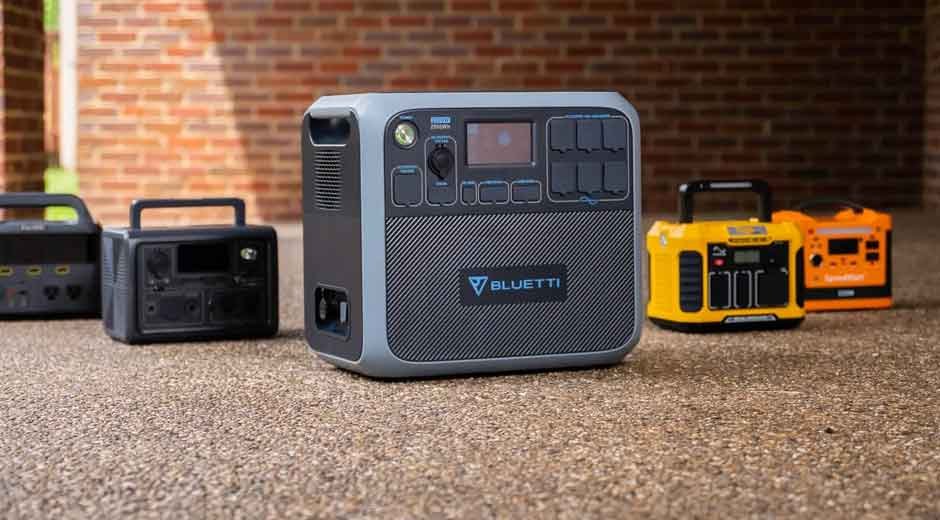Imagine this: You’re in the middle of a vital client presentation, and suddenly your screen goes black. The familiar hum from your computer fades, which is quickly replaced by a jittery sense of panic when you realize that you’ve lost power. Now, this dystopian vision is being realized by remote workers of all stripes, with detrimental effects on productivity and professional reputation.
Today’s home offices, while offering flexibility and convenience, harbor a critical vulnerability: complete dependence on stable electricity. With our workspaces filled with essential electronics – from computers and monitors to routers and VoIP phones – even brief power interruptions can derail an entire workday.
In comes the age of portable power stations; a new answer to this essential question. These small, battery-driven devices are essentially personal power plants, poised to take over without missing a beat from your primary power supply. Unlike standard backup systems, these units provide clean and quiet network-grade power that is ideal for maintaining a professional environment using electronics.
In this guide, we’ll explore how these innovative devices can transform your home office into a resilient workspace, ensuring you stay connected and productive regardless of external power conditions.
Why Home Offices Need Backup Power Solutions
The latest statistics from the U.S. Department of Energy paint a grim picture: power outages are up 60% since 2015, and the average U.S. consumer experiences more than eight hours of grid disruptions in a typical year. For some remote workers, these numbers mean real professional repercussions. Man or machine, even one hour of downtime can cost you missed client meetings, vanishing proposals, and ruined professional relationships that take months to mend.
The financial impact is equally concerning. Remote workers lose an average of $130-200 per hour during power outages through missed billable hours, failed transactions, and lost opportunities. For freelancers and independent contractors, these losses can significantly impact monthly income targets and client retention rates.
Traditional backup is not enough for the home office now and then. Gasoline generators are powerful, but they are also too loud and they produce exhaust fumes that are not conducive to residential living. Conventional home- and office-level UPS systems usually give you just 10-15 minutes of battery power; which isn’t enough to see you through a power outage, let alone to keep working during one. The problem is that this old-fashioned solution is no longer adequate for the reality of life in 2023, and modern electrical connectors play a crucial role in providing more reliable backup power protection.
Portable Power Stations Explained
Advanced Lithium-ION Technology Lithium-ion batteries provide up to six times more life cycles than traditional AGM batteries, and they can be recharged up to 100% of their capacity in seconds thanks to bespoke charger technology optimized for Signstek power units. These compact stations incorporate high-density, powerful lithium-ion packs used in Hybrid and Electric vehicles which can be recharged more than 800 times, making them the perfect, eco-friendly power source.
The fundamental architecture is composed of three key components. The first of these is a high-capacity battery pack, which stores between 250 and 1000 watt-hours of energy. Second, a complex inverter conditions stored DC power into reliable AC output that is safe to use for electronics. Third, a variety of input/output port options provides charging and power delivery flexibility. Many units include multiple AC outlets, multiple USB ports, and multiple DC connectors so that you can charge several devices at the same time.
It is directly being applied by these stations on one very basic principle: storage and conversion of energy. You can power them via regular wall outlets, car chargers, or solar panels. At full charge, they perform like quiet, portable power stations, converting stored energy into whatever kind of power your devices can use. With an integrated battery management system, it monitors the temperature, voltage, and current to safeguard your connected device from the potential harms of a power surge.
Essential Features for Home Office Backup Power
Reliability and Performance Metrics
To choose a portable power station for home office, it’s essential to know your power needs. Typically they are in the 500-1000 watt-hour range to keep critical stuff running in the office. Just to give you an idea, a laptop consumes between 45-100 watts, an external monitor uses 20-35 watts, and routers and modems consume 5-10 watts each. And when it comes to home office applications, only a pure sine wave inverter technology will do, protecting even the most sensitive electronics from spikes and dips in power, which can lead to potential data loss or hardware damage.
Compact and Efficient Design
Many contemporary home offices are also confined spaces, where the physical dimensions of backup power options are important. Perfect portable power stations should be typically no bigger than a desktop PC, and the user should be able to easily conceal it under the desk and in the storage cabinet. Weight matters if you’ll be moving the unit around – search for solutions under 30lbs so you won’t be weighed down, but won’t skimp on space. Portable power stations with no mechanical devices make it efficient and quiet, with no operational noise, ideal for keeping working during camping, operating a professional video call when work takes you to a construction site or video producer or focused homework in the park and so on. Almost all units come equipped with efficient cooling mechanisms that do not make any noise, so your work is never affected by any climate conditions.
Output versatility is essential for modern office setups. Look for units offering multiple AC outlets for primary devices, USB-C ports with Power Delivery for fast-charging capabilities, and standard USB ports for accessories. This combination ensures all devices remain powered without requiring additional adapters or power strips.
Solar Generator Integration for Continuous Power
Solar panels convert portable power stations into solar power systems, which generate recurring charging times that will never stop backup battery supplies. Today’s solar panels feature high-efficiency mono-crystalline panels which convert more than 23% of sunlight to power. When connected with portable power stations, such as your Suaoki S270/ Suaoki S200 and Goal Zero Yeti Power Station, these panels can produce the power of 60W-100W under the sun, providing electricity and convenience for your devices while maintaining your off-grid battery life.
Folding solar panels are the best compromise for typical home office usage. These panels are portable and versatile; they can be placed across windows or on balconies with no permanent installation, suitable for both homeowners and renters. The trick is to choose ones which are rated between 100 to 200 watts with the corresponding charging port of your power station. Look for panels with kickstands and weather resistance, so you can use them anywhere.
Perfect positioning needs window alignment & daily sunlight tracking. In the Northern Hemisphere, the most reliable exposure is from south-facing windows. Place your panels so that they can receive sunlight from the sun’s rays; this must be done for the morning and the afternoon. Even on cloudy days, modern panels deliver between 25-35% of their rated output – and this is the critical trickle charging long-term power security.
Step-by-Step: Creating Your Home Office Power Solution
To develop a dependable backup power solution, you start with understanding your power requirements. Determine your basic gadget needs by looking at power specs on your gadgets’ labels, or you can refer to the specs that the manufacturer provides. Most home offices to start should have a conservative estimate based on your computer (45-100W), monitor (20-35W), router (10W), and any other equipment which is essential. Count on 20% more to buffer peak power requirements and for future growth.
Place your portable power station in a convenient spot with airflow—such as within arm’s reach of your workstation. (You can store it close to your main surge protector so you can easily connect it when the power goes out. Hang them high to prevent water damage and so all cords can reach without creating noticeable trip hazards.
Configure automatic power transfer by connecting critical devices through your portable power station’s UPS outlets. These specialized ports instantly switch to battery power during outages. For devices without UPS support, create a prioritized connection sequence starting with communication equipment (router/modem) followed by primary work devices.
Keep your batteries topped off with a regular charging schedule for batteries-as-needed. In the winter when outages are more frequent, keep the charge level above 80%. Something like 50-60% in the summer seems like enough for backup and yet to give the battery a good life. To invest the time on, take an offline test once a month by safely simulating a controlled outage.
In order to reduce human error, write down the steps of your outage response program, detailing what needs to be done at critical devices and machines, what email templates and tweets to use in what order, how to estimate run times, etc. Share this protocol with your team members or family to help expedite execution in the event of a real emergency. You can also include contact information for your power company and alternate spaces to work if the outages last for an extended period of time.
Practical Application in Home Offices
The EcoFlow RIVER 3 is an example of how portable power stations have evolved to meet remote workers’ requirements. Backed by a 600W continuous (2100W surge) true sine wave inverter; this power source can be used to power office equipment and heavy-duty appliances at the same time. The device is smaller than most desks, with a low profile 10.6 x 10.2 x 7.7 inches size and is easy to access from the ground.
In practice, the system is capable of running quite efficiently. A common home office configuration that uses about 200W (laptop, monitor, router, and an LED desk lamp) would run for 4-5 hours on a battery. X-Boost Inverter technology automatically powers electronic equipment during utility outages to provide longer run time for your critical equipment. It also has the ability to adapt to varying home power conditions, and you are able to decide which devices you want to run and those you do not need to run in the case of an outage. During even shorter outages, the X-Boost technology can power more than 20 percent above its continuous rating, so you can power more with lower watts. It offers reliable power for very long outages.
Recent experiences of remote workers illustrate the system’s practical usefulness. A graphic designer was able to keep working at full productivity during a three-hour winter storm outage, running dual monitors and a workstation-class laptop. With the unit running whisper quiet, I was able to participate in video conferences effortlessly and had the app-based monitoring display showing me just how much power I still had at any given time. High-speed AC rapid charging compatibility and built-in solar charging option were both invaluable features for quick recovery between blackouts, showing us just how modern-day portable power can effectively fill the void when utility power goes down and the job remains.
Securing Your Professional Future with Reliable Power
In the current remote working landscape, it’s not just a matter of convenience to keep the power on, it’s about securing your professional reputation and your income. Portable Power Stations have become the best choice for those looking for a clean, reliable, and easily integrated backup power solution in home offices. These quiet sentinels are ready to safeguard your productivity when conventional power fails.
When it’s time to choose a backup power solution, choose what engineers choose to protect their devices: pure sine wave output, and have the energy capacity to make it through. Solar integration can also provide extended independence in the event of long-term outages. Just keep in mind that the short-term cost of investing in a reliable power backup isn’t bad when your work is getting done, and your clients’ needs are being met.
Take action today to secure your remote work environment. Calculate your power requirements, select an appropriately sized solution, and implement a clear power transition protocol. In doing so, you’ll transform your home office from a potentially vulnerable workspace into a resilient professional environment capable of weathering any power disruption.










